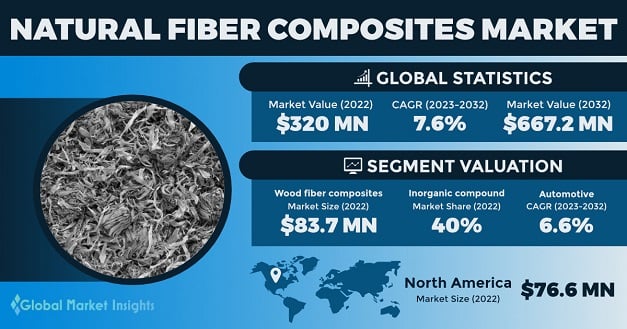Global Natural Fiber Composites Market Outlook To 2029

Table of Contents
Key Drivers Fueling Natural Fiber Composites Market Growth
Several factors are propelling the remarkable growth of the natural fiber composites market.
Sustainable Solutions: The Green Revolution in Materials
The world is increasingly focused on sustainability. Government regulations promoting the use of eco-friendly materials, coupled with rising consumer awareness of environmental issues, are creating a significant demand for sustainable alternatives to traditional materials such as fiberglass and plastics. Natural fiber composites offer a compelling solution, reducing reliance on petroleum-based products and minimizing environmental impact throughout their lifecycle.
- Reduced Carbon Footprint: Natural fiber production generally requires less energy and emits fewer greenhouse gases compared to synthetic fiber production.
- Biodegradability: Many natural fibers are biodegradable, reducing landfill waste and environmental pollution.
- Government Incentives: Many countries are introducing policies and incentives to encourage the adoption of sustainable materials, including natural fiber composites.
Cost-Effectiveness: A Competitive Edge
Compared to synthetic alternatives like carbon fiber or fiberglass, natural fibers are significantly more cost-effective. This price advantage makes natural fiber composites a highly attractive option for a wider range of applications, especially in price-sensitive markets.
- Lower Raw Material Costs: Natural fibers are often readily available and less expensive than synthetic fibers.
- Reduced Manufacturing Costs: In some cases, the processing of natural fibers can be simpler and less energy-intensive than that of synthetic fibers.
- Improved ROI: The lower initial cost of natural fiber composites can translate into improved return on investment for manufacturers.
Lightweight Properties: Enhanced Performance and Efficiency
The lightweight nature of natural fiber composites is a significant advantage across numerous applications. This property leads to improved fuel efficiency in vehicles, reduced weight in construction materials, and enhanced performance in various products.
- Automotive Industry: Reduced vehicle weight translates to better fuel economy and lower emissions.
- Aerospace Industry: Lighter aircraft components improve fuel efficiency and enhance maneuverability.
- Construction Industry: Lightweight building materials can reduce transportation costs and improve structural efficiency.
Superior Mechanical Properties: Tailored Performance
Through careful selection of fiber type and processing techniques, natural fiber composites can achieve remarkable mechanical properties. The inherent strength, stiffness, and other characteristics of different fibers (e.g., the tensile strength of flax, the flexibility of hemp) allow for tailoring the composite to specific application requirements.
- Flax: High tensile strength, making it suitable for automotive and construction applications.
- Hemp: Excellent damping properties, ideal for noise reduction and vibration control.
- Jute: Cost-effective and suitable for applications requiring lower strength requirements.
Innovation in Processing Technologies: Expanding Applications
Advancements in manufacturing technologies are continuously enhancing the performance and scalability of natural fiber composites. Innovations in processes such as pultrusion, injection molding, and resin transfer molding are expanding the range of potential applications.
- Pultrusion: Enables the production of continuous fiber-reinforced profiles with high precision.
- Injection Molding: Allows for mass production of complex shapes with natural fiber composites.
- Resin Transfer Molding: Offers flexibility in material selection and design, enabling the creation of high-performance components.
Natural Fiber Types and Their Applications
The natural fiber composites market encompasses a variety of fibers, each with its unique properties and applications.
Flax Fiber Composites
Flax fiber composites are gaining traction in the automotive, construction, and aerospace industries due to their high tensile strength and relatively low cost. The market for flax fiber composites is projected to grow significantly in the coming years, reaching [Insert Market Size Estimation] by 2029.
Hemp Fiber Composites
Hemp fiber composites possess excellent damping properties and are increasingly used in automotive interiors, noise reduction, and construction applications. The unique properties of hemp, including its biodegradability and rapid growth rate, make it a promising sustainable material. Market growth for hemp fiber composites is anticipated to reach [Insert Market Size Estimation] by 2029.
Jute Fiber Composites
Jute fiber composites, known for their cost-effectiveness and sustainability, find widespread use in packaging, construction, and automotive industries, particularly in applications where high strength is not critical. The market is expected to show [Insert Market Trend/Forecast] growth.
Other Natural Fibers
Other significant natural fibers, including sisal, bamboo, and kenaf, also contribute to the natural fiber composites market. Their applications vary depending on their individual properties and are found in diverse sectors, from packaging to construction.
Geographic Market Analysis: Regional Growth Trends
The global natural fiber composites market exhibits varied growth patterns across different regions.
North America
North America is a significant market for natural fiber composites, driven by increasing environmental awareness, supportive government policies, and a focus on sustainable manufacturing practices. The market is expected to grow at a [Insert Growth Rate] CAGR until 2029.
Europe
Europe is another key region for natural fiber composites, with strong government regulations promoting sustainable materials and a significant focus on reducing carbon emissions. The European market is projected to grow at a [Insert Growth Rate] CAGR until 2029.
Asia-Pacific
The Asia-Pacific region is experiencing rapid growth in the natural fiber composites market, driven by increasing industrialization, rising disposable incomes, and a growing demand for cost-effective and sustainable materials. The market is projected to grow at a [Insert Growth Rate] CAGR until 2029, representing the fastest growing region.
Rest of the World
Other regions, including South America, Africa, and the Middle East, are also witnessing a gradual increase in the adoption of natural fiber composites, albeit at a slower pace compared to the aforementioned regions.
Competitive Landscape and Key Players
The global natural fiber composites market is characterized by a mix of established players and emerging companies. Key players include [List Major Players], each employing various competitive strategies to gain market share. The industry is also witnessing increased mergers, acquisitions, and strategic partnerships, driving innovation and consolidation. Emerging players are entering the market with innovative processing techniques and novel applications for natural fiber composites.
Challenges and Future Outlook
Despite the significant growth potential, the natural fiber composites market faces certain challenges.
- Standardization: Lack of standardized testing procedures and specifications can hinder wider adoption.
- Scalability: Scaling up production to meet increasing demand requires further technological advancements.
- Performance Consistency: Maintaining consistent performance across different batches of natural fibers remains a challenge.
However, ongoing research and development efforts are addressing these challenges, leading to improvements in processing techniques, material properties, and the overall performance of natural fiber composites. The future outlook for the natural fiber composites market remains highly positive, with significant growth opportunities across various sectors. Further innovations are expected to overcome the present limitations, unlocking the full potential of these sustainable materials.
Conclusion: Investing in the Future of Sustainable Materials: The Natural Fiber Composites Market
The global natural fiber composites market presents a compelling investment opportunity. Driven by the increasing demand for sustainable alternatives, cost-effectiveness, lightweight properties, and superior mechanical characteristics, this sector is poised for remarkable growth in the years to come, with projections reaching [Insert Projected Market Size] by 2029. The key drivers highlighted—sustainability, cost-effectiveness, and performance advantages—underscore the long-term viability and growth potential of natural fiber composites. Explore the vast potential of the natural fiber composites market and discover how your business can benefit from this rapidly growing sector. Learn more about the latest innovations and market trends shaping the future of sustainable materials.

Featured Posts
-
 Bosses Talk Tough The Shifting Power Dynamic In The Workplace
May 13, 2025
Bosses Talk Tough The Shifting Power Dynamic In The Workplace
May 13, 2025 -
 A Critical Examination Of The Da Vinci Codes Literary Merit
May 13, 2025
A Critical Examination Of The Da Vinci Codes Literary Merit
May 13, 2025 -
 Leonardo Di Caprio Faces Intense Backlash The Full Story
May 13, 2025
Leonardo Di Caprio Faces Intense Backlash The Full Story
May 13, 2025 -
 Gibraltar Sovereignty Dispute Intensifies Labour Leaders Defiant Response
May 13, 2025
Gibraltar Sovereignty Dispute Intensifies Labour Leaders Defiant Response
May 13, 2025 -
 Beyonces Demanding Script Revisions The Hollywood Producers Five Time Rewrite
May 13, 2025
Beyonces Demanding Script Revisions The Hollywood Producers Five Time Rewrite
May 13, 2025
